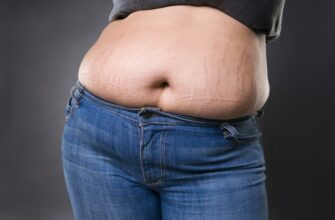Belly fat is a common concern for many people, and it’s often considered a stubborn area that’s hard to target with diet and exercise. But before you can effectively address belly fat, it’s important to understand what it is and how it forms.
1. What is Belly Fat?
Belly fat, also known as visceral fat, is the fat that accumulates around the organs in your abdominal cavity. This type of fat is considered dangerous because it can increase your risk of various health problems, including heart disease, diabetes, and certain cancers.
2. How Does Belly Fat Form?
Belly fat forms when your body stores excess calories as fat. These excess calories can come from overeating, a sedentary lifestyle, or a combination of both. Hormones and genetics also play a role in the accumulation of belly fat.
3. What Are the Health Risks of Belly Fat?
Belly fat has been linked to numerous health problems, including insulin resistance, high blood pressure, high cholesterol, and heart disease. It’s also associated with an increased risk of certain cancers, such as breast and colorectal cancer.
4. Can Belly Fat Be Measured?
Yes, belly fat can be measured using waist circumference or waist-to-hip ratio. A waist circumference of more than 35 inches for women and 40 inches for men is considered a risk factor for health problems related to belly fat.
5. Can Exercise Help Reduce Belly Fat?
Yes, exercise can help reduce belly fat by burning calories and increasing muscle mass. Cardiovascular exercise and strength training are both effective for reducing belly fat.
6. What Role Does Diet Play in Reducing Belly Fat?
Diet plays a significant role in reducing belly fat. A diet rich in whole, nutrient-dense foods and low in processed foods and sugar can help reduce belly fat.
7. Can Supplements Help Reduce Belly Fat?
There is no magic pill for reducing belly fat. While some supplements may claim to reduce belly fat, they are not a substitute for a healthy diet and regular exercise.
8. What Lifestyle Changes Can Help Reduce Belly Fat?
Lifestyle changes such as regular exercise, a healthy diet, stress reduction, and getting enough sleep can all help reduce belly fat.
9. Can Belly Fat Be Dangerous for Thin People?
Yes, even thin people can have dangerous levels of belly fat. This is known as “skinny fat,” where a person has a normal weight but a high percentage of body fat, especially in the belly area.
10. Is Spot-Reducing Belly Fat Possible?
No, spot-reducing belly fat is not possible. While exercise and a healthy diet can help reduce overall body fat, you cannot target specific areas for fat loss.
11. Can Belly Fat be Reduced Without Losing Weight?
Yes, it is possible to reduce belly fat without losing weight. Building muscle through strength training can help reduce belly fat and improve overall body composition.
12. The Bottom Line
Belly fat is a common concern, but it’s important to understand that it’s not just a cosmetic issue. Belly fat can be dangerous and is linked to numerous health problems. A healthy lifestyle that includes regular exercise, a nutritious diet, stress reduction, and adequate sleep can all help reduce belly fat and improve overall health.
Conclusion
In conclusion, the truth about belly fat is that it’s not just a cosmetic issue, but a health concern that should be taken seriously. While there is no magic pill or quick fix for reducing belly fat, a healthy lifestyle that includes regular exercise, a nutritious diet, stress reduction, and adequate sleep can help reduce belly fat and improve overall health.
Remember, small changes can lead to big results. Start by incorporating healthy habits into your daily routine, such as taking a daily walk, choosing nutritious foods, and managing stress through meditation or other stress-reducing activities. With dedication and consistency, you can achieve a healthier body composition and reduce your risk of health problems associated with belly fat.











